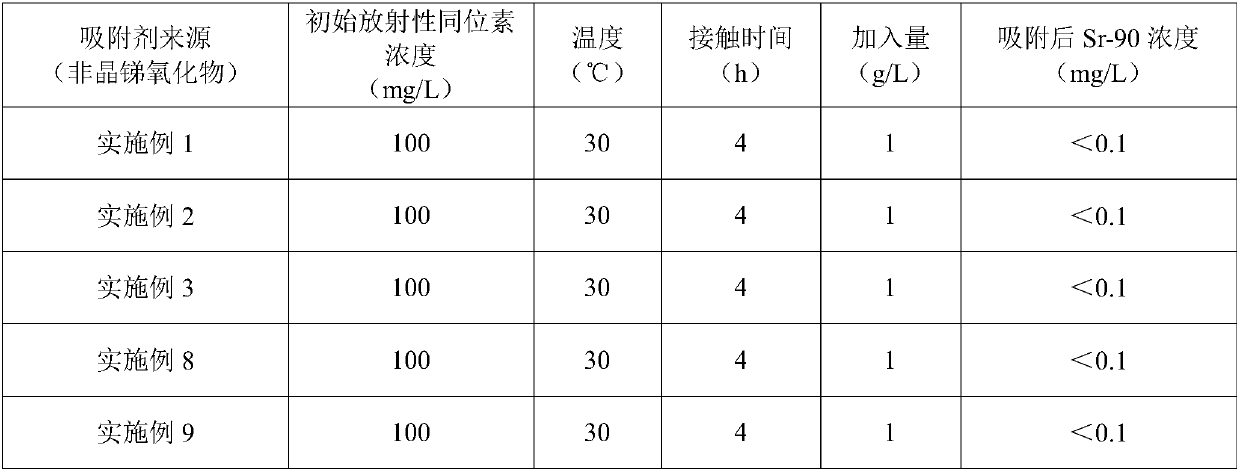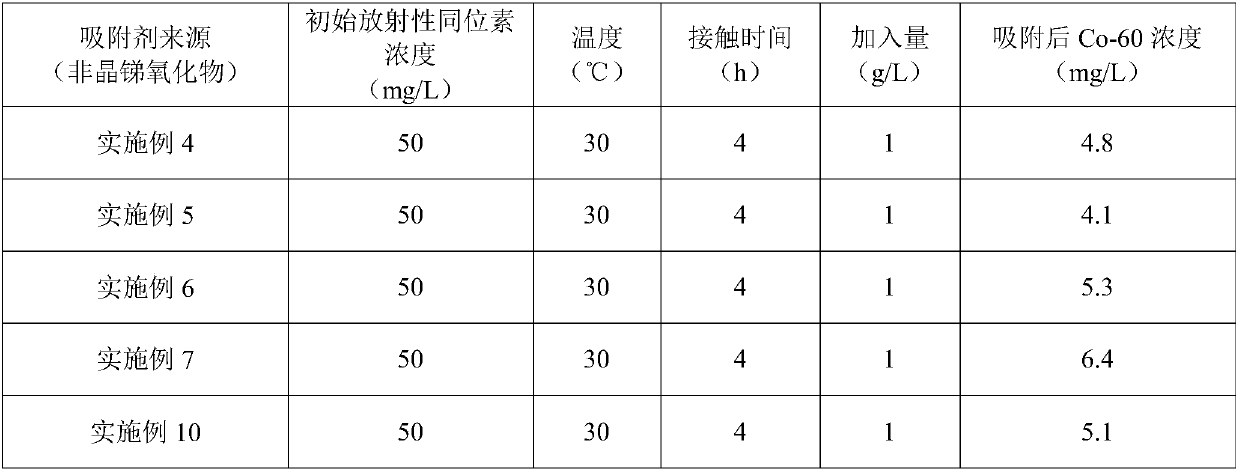Amorphous antimony oxide for adsorbing radioactive strontium-90 and cobalt-60 and preparation method of amorphous antimony oxide
An antimony oxide and radioactive strontium technology is applied in the field of amorphous antimony oxide and its preparation, which can solve the problems of small adsorption capacity, short service life and poor effect, and achieve the effects of simple steps, low cost and many pores.
- Summary
- Abstract
- Description
- Claims
- Application Information
AI Technical Summary
Problems solved by technology
Method used
Image
Examples
Embodiment 1~5
[0043] A method for preparing amorphous antimony oxides for absorbing radioactive strontium-90 and cobalt-60, the method comprising the following steps:
[0044] 1) taking antimony trichloride and hydrochloric acid as raw materials, weighing and mixing to obtain a mixed solution;
[0045] 2) Place the mixed solution in a water bath, add hydrogen peroxide to oxidize for 1 hour, then mix the oxidized mixed solution with a large amount of water for hydrolysis, filter and separate the hydrolyzate after hydrolysis, and use it to adsorb radioactive strontium-90 and Amorphous antimony oxide of cobalt-60.
[0046] The specific preparation parameters of Examples 1-5 are shown in Table 1.
[0047] Table 1 preparation process parameters
[0048]
[0049] The amorphous antimony oxides prepared in Examples 1-5 were detected. After testing, the average particle diameters of Examples 1-5 are all in the range of 60-150nm, and the specific surface area of the prepared amorphous antimon...
Embodiment 6~10
[0051] The preparation steps of Examples 6-10 respectively correspond to Examples 1-5 in turn, only hydrogen peroxide is replaced by chlorine gas and added. The volume ratio of chlorine used in Example 6 to the mixed solution is 50:1, and the speed of feeding chlorine is 50mL / min; the volume ratio of chlorine used in Example 7 to the mixed solution is 80:1, and the speed of feeding chlorine is 100mL / min. min; the volume ratio of chlorine gas used in embodiment 8 and mixed solution is 80:1, and the speed of feeding chlorine gas is 120mL / min; the volume ratio of chlorine gas used in embodiment 9 and mixed solution is 100:1, and the speed of feeding chlorine gas is 100:1. 150mL / min; the volume ratio of chlorine gas to the mixed solution used in Example 10 was 100:1, and the rate of introducing chlorine gas was 200mL / min.
[0052] The amorphous antimony oxides prepared in Examples 6-10 were detected. After testing, the average particle diameters of Examples 6-10 are all in the ra...
PUM
| Property | Measurement | Unit |
|---|---|---|
| The average particle size | aaaaa | aaaaa |
| Specific surface area | aaaaa | aaaaa |
| Adsorption capacity | aaaaa | aaaaa |
Abstract
Description
Claims
Application Information
 Login to View More
Login to View More - R&D
- Intellectual Property
- Life Sciences
- Materials
- Tech Scout
- Unparalleled Data Quality
- Higher Quality Content
- 60% Fewer Hallucinations
Browse by: Latest US Patents, China's latest patents, Technical Efficacy Thesaurus, Application Domain, Technology Topic, Popular Technical Reports.
© 2025 PatSnap. All rights reserved.Legal|Privacy policy|Modern Slavery Act Transparency Statement|Sitemap|About US| Contact US: help@patsnap.com



